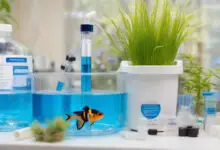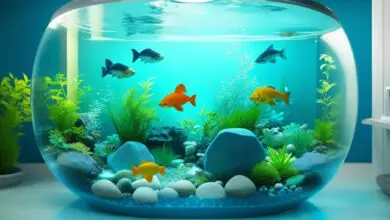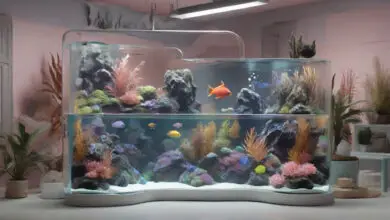How To Deal with Algae Blooms in Your Fish Tank

Algae blooms happen when there is too much algae growing in one place. Algae is a simple plant that lives in freshwater and saltwater. It grows using sunlight, carbon dioxide, and nutrients from the water.
Usually a small amount of algae is okay and even helpful in aquariums because it provides oxygen for fish and helps process waste. But too much algae can look unhealthy and make the tank water dirty.
When conditions are just right for algae, like lots of nutrients and sunlight, it can grow out of control quickly. This is called an algae bloom. Blooms happen when there is an imbalance that allows algae to multiply too fast.
Causes of Algae Blooms
There are some common reasons why aggressive algae blooms may occur:
-
Natural Algae Control MethodsDecember 21, 2023
-
How to Care for Sick Fish: Effective Quarantine PracticesDecember 18, 2023
-
Aquarium Upgrades to Make Cleaning and Care Much EasierDecember 18, 2023
-
Natural and Chemical Ways to Make Water Clean for TanksDecember 18, 2023
-
Too much light – Strong lights on for too long each day give algae more time to photosynthesize and multiply.
-
Too many nutrients – Excess fish food or waste provides extra fertilizer for algae to feed on. Overstocked tanks often have this problem.
-
Not enough water changes – Stagnant water builds up nutrients algae love over time if not refreshed regularly.
-
Low oxygen levels – Algae does better than fish and plants when oxygen is low, giving it an advantage.
The table below summarizes some typical causes of algae blooms:
| Cause | Details |
|---|---|
| Too much light | Lights on 10+ hours per day provide ideal growing conditions. |
| Overfeeding | Leftover fish food clouds water with nutrients. |
| Not enough plants | Aquatic plants outcompete algae for nutrients when present. |
Signs of an Algal Bloom
It is important to watch for signs that algae is beginning to overgrow to address the problem before it gets too bad. Some common indicators include:
- Green or other colored cloudy water that limits visibility
- Floating or stringy green clumps of algae visible throughout the tank
- Covering of glass, hardscaping, plants, and other surfaces
- Algae hair and whiskers emerging from decorations and filters
- Lack of breathing room for fish or blocked access to food
- Changes in water parameters like pH or ammonia
The table below summarizes visual signs of aggressive algae blooms:
| Sign | Appearance |
|---|---|
| Cloudy water | Water turns hazy or opaque green/brown color. |
| String algae | Thin green/brown strings or hair-like growths. |
| Blanket algae | Thick coatings or mats on glass, rocks, plants. |
Methods for Controlling Blooms
When an algae bloom gets out of control, these methods can help bring it back under control:
Adjust Lighting and Photoperiod
- Reduce lighting intensity by raising lights higher or switching to weaker bulbs
- Shorten the photoperiod to 8 hours or less until the bloom subsides
Improve Water Flow and Surface Agitation
- Add a powerhead filter or increase sponge filter airflow
- Position decorations and plants to open up the tank layout
- Increase surface agitation to boost gas exchange
Increase Beneficial Bacteria
- Add carbon supplements to improve waste processing
- Add botanicals or starter bacteria to balance the ecosystem
Manually Remove Algae Growth
- Use an algae scraper to wipe off glass, rocks, decorations
- Use a siphon tube to vacuum algae off the substrate
- Prune infected plant leaves and dispose of them
Spot Treat with Algaecides
- Spot treat stubborn algae in isolated areas with hydrogen peroxide
- Use erythromycin or similar medications as a last resort
Maintaining Balance Moving Forward
It takes time for an ecosystem to recover from an algal bloom. Be patient and keep tank maintenance consistent. Monitor water parameters closely and adjust as needed. Make small gradual changes and see how the tank responds before rushing into anything. With care and attention, the balanced state can return.
H3: Nutrient Reduction Strategies
One of the best ways to prevent future algal blooms from occurring is to minimize excess nutrients in the tank that algae feeds on. Here are some effective techniques:
Control Fish Waste
Algae thrives on ammonia from fish waste in the water. It’s important not to overstock the aquarium and to perform regular gravel vacuuming or substrate cleaning to remove built-up waste.
Balance Feed Amount
Only feed as much as fish can consume in 2-3 minutes, twice per day. Uneaten food accumulates and decays, releasing nutrients. Use feeding rings or target feeding to minimize leftover food.
Stock Slow-Growing Live Plants
Fast-growing aquatic plants outcompete algae by absorbing nutrients from the water. Good options include Amazon swords, anubias, java ferns, mosses, and cryptocorynes.
Use Algae-Control Supplements
Products containing enzymes or bacteria help break down waste to limit algae nutrient supply. These supplements are beneficial when added according to package directions.
Avoid Stagnant Water
Performing twice weekly water changes of 20-30% volume refreshes carbon dioxide levels in addition to removing nutrients. Add aquarium salt or use a gravel vacuum during each change.
The following table summarizes some common nutrient-reducing strategies:
| Strategy | Impact |
|---|---|
| Regular substrate cleaning | Removes waste buildup feeding algae. |
| Targeted feeding | Minimizes leftover food dissolving in water. |
| Slow-growing live plants | Compete with algae by absorbing nutrients. |
| Water changes | Refreshes CO2 and removes excess molecules. |
With diligent maintenance focusing on nutrient control, it’s possible to prevent future algal blooms and keep the tank healthy long-term.
Ecosystem Balancing Methods
In addition to reducing excess nutrients that fuel algae growth, it’s important to ensure balanced populations of all organisms in the aquarium ecosystem. This discourages any one type from overpopulating.
Beneficial Bacteria Supplements
Adding bottles of safe, pre-made bacteria cultures helps speed up the nitrogen cycle by seeding the tank with critical nitrifying bacteria. This prevents ammonia spikes and improves waste management.
Snail and Shrimp Introduction
Little invertebrates like ramshorn snails and neocaridina shrimp patrol the tank and graze on microalgae and biofilm all day long. Their tiny forms have a big impact on keeping algae under control.
Dosing with Excel
Excel contains carbon that aquatic plants readily absorb but algae finds toxic. Careful dosing following package instructions gives plants an advantage for a period of time. This can help reduce particularly stubborn algal types.
Introduction of Stem Plants
Adding floating plants or fast-growing stem varieties that root in the substrate or attach to decorations utilizes tank nutrients that would otherwise support algae. Rotala, water sprite, and hornwort spread quickly.
Fish Selection for Grazing
Certain fish species help graze algae off surfaces and supplement their diet with it. Some good options are otocinclus catfish, nerite snails, amano shrimp. Choose species appropriate for your aquarium size.
Common ecosystem balancing stock
| Type | Species | Impact |
|---|---|---|
| Beneficial bacteria | Tetra SafeStart, Fritz Zyme 7 | Speeds up nitrogen cycle to prevent waste spikes. |
| Algae-grazing inverts | Ramshorn snails, neocaridina shrimp | Remove microalgae and biofilm that algae needs to establish. |
| Floating stem plants | Duckweed, salvinia, frogbit | Uptake available nutrients and block sunlight reaching lower plants. |
| Rooted stem plants | Hygrophila, red rotala, ludwigia | Grow densely to compete intensely with algae for resources. |
| Algae-eating fish | Otocinclus, nerite snails, amano shrimp | Graze surfaces and supplement natural diet with available algae. |
Nature is all about checks and balances. Careful maintenance and stocking the right “balance keepers” makes the whole greater than the sum of its parts by preventing any single element like algae from dominating.
Maintain a Stable Environment
Providing consistent conditions helps keep all organisms in the ecosystem healthy and peacefully coexisting. Parameters like temperature, pH, lighting cycle, etc. should not fluctuate too high or low to stress inhabitants. Stress invites opportunity for algae to seize competitive advantage.
Avoid Phosphate Buildup
Phosphate builds up from food, waste and common filter media over time. Excess phosphate spurs algal blooms. Test levels periodically and address spikes immediately through water changes or replacement of filter floss/media.
Carbon Dioxide Supplementation
Adding CO2 increases plant growth and photosynthesis to outpace algae. Use diffusers or liquid carbon dosing when needed but be cautious not to overdose, stressing ecosystem balance. Excess drops pH and oxygen levels.
Macro and Micro Nutrient Variety
Plants require a full range of macros like nitrogen, potassium and phosphorus plus micros like iron to thrive over algae. Supplement appropriate levels tailored to plant needs through all-in-one or individual dosing.
Target Removal of Recurring Algae Types
While reducing excess nutrients prevents many types from establishing, sometimes a stubborn variety persists. Manual removal plus a short targeted treatment may stamp it out. Common options:
- Hydrogen peroxide (3% concentration) spot treatment for cyanobacteria
- Erythromycin to treat staghorn algae short term
- Algaefix/Algae Destroyer to control cladophora/hair algae
Always do thorough water changes after to remove all medication residues that could otherwise harm sensitive stock.
Planted Tank Tweaks
Here are a few specialized tips for planted aquariums geared towards successful plants thriving over algae:
- Increase biofiltration capacity with more plant roots and more porous filter media
- Add nutrient-rich substrate like aquasoils or root tabs near rooted plants
- Upgade lighting to optimal intensity/spectrum/duration for chosen flora
- Balance macro and micro nutrients focused on plant needs through dosing
- Gradually convert to liquid CO2 or pressurized systems as budget allows
Long-term Maintenance Plan
The key to maintaining long-term algae control is establishing regular maintenance routines. Stay on top of:
-
Water changes 1-2 times weekly depending on bioload
-
Gravel vacuuming during each change to stir detritus and remove built up organics
-
Topping off evaporation between changes to maintain stable parameters
-
Thorough cleaning of equipment like filters, heaters, tubing monthly
-
Trimming and replanting aquatic plants as needed
-
Testing and adjusting water parameters with natural fertilizers as plants uptake nutrients
-
Spot treating any recurrent problem algae immediately before it spreads
-
Journaling observations, parameter readings, stock and tank adjustments over time
Research has proven fish are healthier and live longer with consistent care routines. The same is true for managing a balanced ecosystem. Sticking to a personalized protocol fosters an environment where algae struggles to gain any footholds at all.







